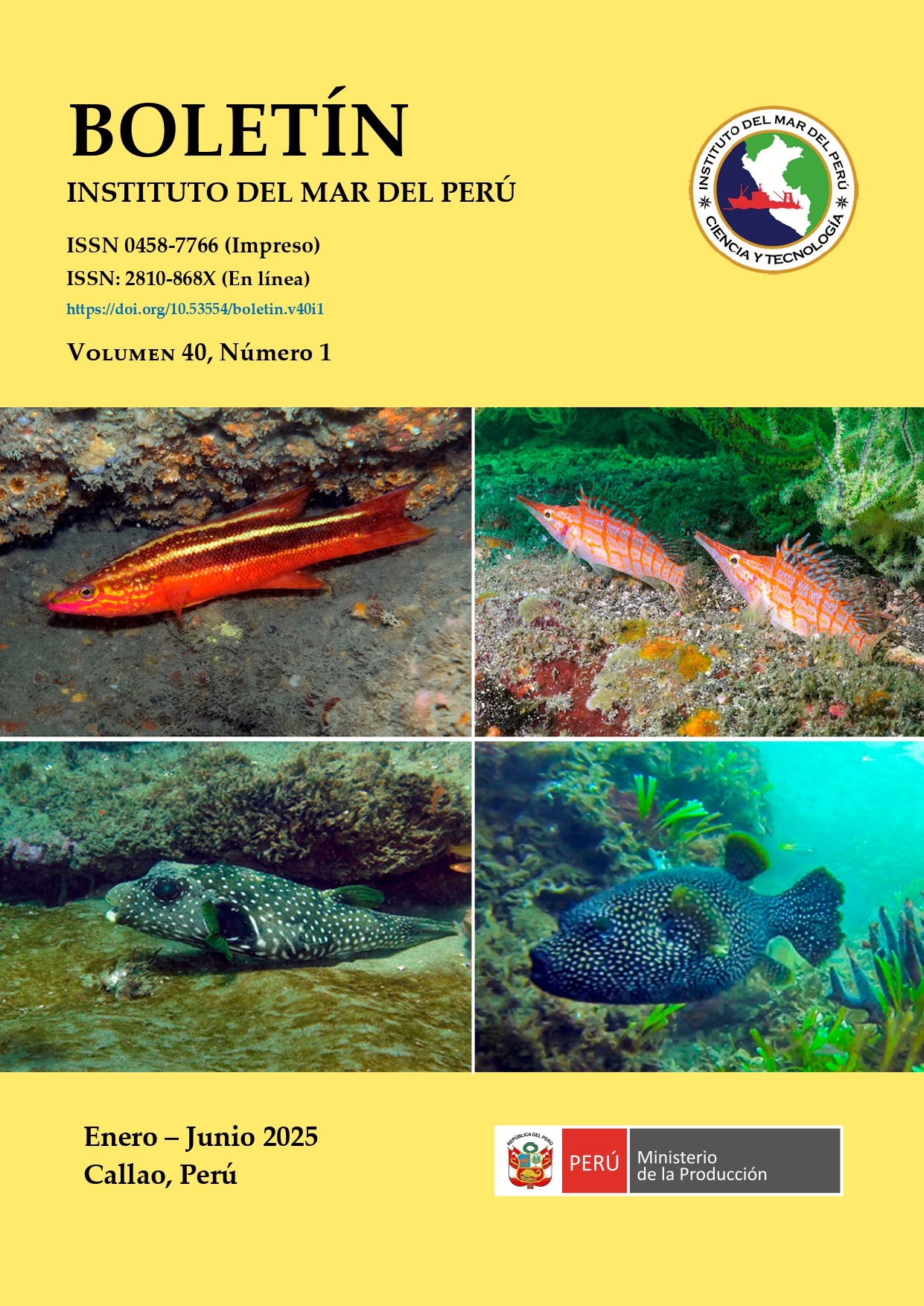First record of the atlantic tarpon Megalops atlanticus (Elopiformes: Megalopidae) in the Southeast Pacific, Peru
DOI:
https://doi.org/10.53554/boletin.v40i1.430Keywords:
Migration, biogeography, transoceanic, non-native speciesAbstract
The tarpon Megalops atlanticus Valenciennes, 1847, a native fish of the Atlantic Ocean, is recorded for the first time in the Southeast Pacific region (Peru). It is presumed that about 80 years ago this species crossed from the Atlantic to the Pacific through the Panama Canal, adapting and expanding its distribution to the north and south in the Tropical Eastern Pacific (currently distributed from Guatemala to southern Colombia). A specimen measuring 129 cm in length and 18 kg in weight was recorded, caught by an artisanal fisherman with his net, in the locality of Bonanza, Tumbes, in northern Peru (3°42’44.47”S - 80°44’35.51”W). This is the first record of Megalops atlanticus in Peru extending >500 km to the south its distribution range in the eastern Pacific Ocean.
Downloads
Alternative Metrics
Metrics
References
Adams, A., Guindon, K., Horodysky, A., MacDonald, T., McBride, R., Shenker, J. & Ward, R. (2019). Megalops atlanticus (errata version published in 2020). The IUCN Red List of Threatened Species, e.T191823A174796143. https://dx.doi.org/10.2305/IUCN.UK.2019-2.RLTS.T191823A174796143.en
Bañón, R., Farias, C., De Carlos, A., Arronte, J. C., Varela, J. L., Arias, A., Barros-García, D. & Gonzalez-Ortegon, E. (2019). New record and revised list of Megalops atlanticus (Elopiformes: Megalopidae) from Atlantic European waters. Cybium, 43(2), 203-207. https://doi.org/10.26028/cybium/2019-423-009
Barraza, J. E. (2018). New distribution record of Megalops atlanticus Valenciennes, 1847 (Elopiformes, Megalopidae) in El Salvador, Eastern Pacific Ocean. Check list, 14(5), 933-935. https://doi.org/10.15560/14.5.933
Castellanos-Galindo, G. A., Robertson, D. R., Sharpe, D. M. T. & Torchin, M. E. (2020). A new wave of marine fish invasions through the Panama and Suez canals. Nature Ecology & Evolution, 4(11), 1444-1446. https://doi.org/10.1038/s41559-020-01301-2
Castellanos-Galindo, G. A., Robertson, D. R., Pacheco-Chaves, B., Angulo, A. & Chong-Montenegro, C. (2019). Atlantic Tarpon in the Tropical Eastern Pacific 80 years after it first crossed the Panama Canal. Rev Fish Biol Fisheries, 29, 401-416. https://doi.org/10.1007/s11160-019-09565-z
Costello, K. E., Lynch, S. A., McAllen, R., O’Riordan, R. M. & Culloty, S. C. (2022). Assessing the potential for invasive species introductions and secondary spread using vessel movements in maritime ports. Marine Pollution Bulletin, 177, 113496. https://doi.org/10.1016/j.marpolbul.2022.113496
Froese, R. & Pauly, D. (Eds.). (2024). Megalops atlanticus. FishBase. Consultado en febrero 2024. https://www.fishbase.se/summary/1079
Griffin, L. P., Casselberry, G. A., Markowitz, E. M., Brownscombe, J. W., Adams, A. J., Horn, B., Cooke, S. J. & Danylchuk, A. J. (2023). Angler and guide perceptions provide insights into the status and threats of the Atlantic tarpon (Megalops atlanticus) fishery. Marine Policy, 151, 105569. https://doi.org/10.1016/j.marpol.2023.105569
Hildebrand, S. F. (1937). The tarpon in the Panama Canal. The Scientific Monthly, 44, 239–248. https://www.jstor.org/stable/16181
Hildebrand, S. F. (1939). The Panama Canal as a passageway for fishes, with lists and remarks on the fishes and invertebrates observed. Zoologica, 24, 15–45.
Hixon, M. A., Green S. J., Albins, M. A., Akins, J. L. & Morris Jr., J.A. (2016) Lionfish: a major marine invasion. Mar Ecol Prog Ser., 558, 161-165. https://doi.org/10.3354/meps11909
Luo, J., Ault, J. S., Ungar, B. T., Smith, S. G., Larkin, M. F., Davidson, T. N., Bryan, D. R., Farmer, N.A., Holt S.A., Alford A. S., Adams A. J., Humston, R., Marton A.S., Mangum D., Kleppinger R., Requejo, A. & Robertson, J. (2019). Migrations and movements of Atlantic tarpon revealed by two decades of satellite tagging. Fish and Fisheries, 00, 1-29. https://doi.org/10.1111/faf.12430
McCosker, J. E. & Dawson, C.E. (1975) Biotic passage through the Panama Canal, with particular reference to fishes. Marine Biology, 30, 343–351. https://doi.org/10.1007/BF00390639
Neira, A. & Acero P., A. (2016). Megalops atlanticus (Megalopidae), un nuevo pez en el Océano Pacífico; información sobre su importancia pesquera. Revista MVZ Córdoba, 21(3), 5525-5534. https://doi.org/10.21897/rmvz.826
Robertson, D., Allen, G., Peña, E. & Estape, A. (2024). Peces Costeros del Pacífico Oriental Tropical: sistema de Información en línea (Versión 3.0). Instituto Smithsonian de Investigaciones Tropicales. https://biogeodb.stri.si.edu/sftep/es/thefishes/taxon/2544
Stephens, S. A., Dance, M.A., Zapp Sluis, M., Kline, R. J., Streich, M.K., Stunz, G. W., Adams, A. J., David Wells, R. J. & Rooker, J. R. (2024). Spatial distribution and movement of the Atlantic tarpon (Megalops atlanticus) in the northern Gulf of Mexico. Plos One, 19(3), e0298394. https://doi.org/10.1371/journal.pone.0298394
Swanson, P. L. (1946). Tarpon in the Pacific. Copeia, (3), 175. https://doi.org/10.2307/1438751
Yu, R., Wu, Q., Li, F., Zhan, A., Zhou, J. & Li, S. (2024). Risk Assessment of Invasive Aquatic Species and a Survey of Fish Diversity Using Environmental DNA Metabarcoding Analysis in Shanghai. Diversity, 16, 29. https://doi.org/10.3390/d16010029
Downloads
Published
How to Cite
Issue
Section
License
Copyright (c) 2025 Boletin Instituto del Mar del Perú

This work is licensed under a Creative Commons Attribution-NonCommercial-ShareAlike 4.0 International License.









